BLADDER SLING (TVT sling) and Stress Urinary Incontinence
Definition of Stress Urinary Incontinence.
- Stress incontinence. Urinary leakage with coughing, laughing, sneezing, and any type of physical activity. In more severe cases, just walking or going from the sitting to the standing position causes urinary accidents. Treatment options for stress incontinence.
- First line of treatment. Kegel exercises. If you leak only a few times a month (e.g. 1-2 times per month), conservative management with Kegel exercises is the best option.
- Second line of treatment. Bladder sling (either a TOT sling or TVT sling). If you leak multiple times a week and this leakage is affecting your everyday quality of life, then next step is to consider a bladder sling. These bladder slings are now the gold standard in the surgical treatment of stress urinary incontinence. The TOT and TVT slings have almost wiped out every other surgical incontinence procedure in the last 50 years. These bladder sling procedures are quick 30-minute, outpatient procedures with a high success rate of approximately 90%. The incisions are small (less than one centimeter), the recovery is fast (less than one week), and the complication rate is very low.
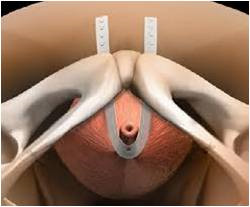
TVT sling
Types of bladder slings:
The two most common types of bladder slings are:
- For the MILD to MODERATE stress incontinence, the TOT sling (transobturator tape sling) is the best choice. A common example is a patient who leaks multiple times a week. She needs to wear a thin pad regularly or she decreases her exercise activities because of fears of a urinary accident.
- For the SEVERE and “Ridiculously” SEVERE stress incontinence, the TVT sling (tension-free vaginal tape sling) is the best choice. A common example is a patient who needs to wear a heavy duty pad every day and she changes her pad multiple times a day. She leaks urine with simple activities like walking or even going from the sitting to the standing position.
- Mini sling. This is potentially a third type of sling. However, the mini sling has a significantly HIGHER FAILURE RATE and this sling is no longer commonly used. For instance, one specific brand of the mini sling has already been removed from the market because of poor success rates.
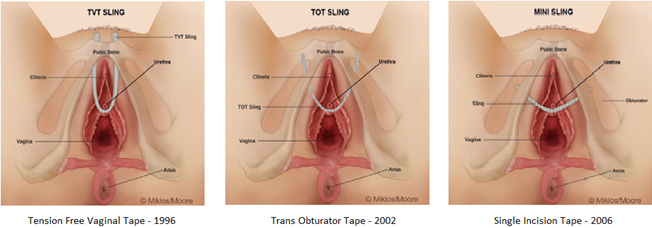
How does the sling work?
The basic concept behind stress incontinence is that the urethra tends to fall down with stress urinary incontinence (e.g. coughing, laughing, sneezing, or any type of physical activity). When the urethra is hypermobile (falling down), the urethra loses its watertight seal, urine escapes from the urethral opening, and one leaks. The bladder sling acts like a hammock underneath the urethra, to provide support underneath the urethra. Therefore, when the urethra tries to fall down, the sling provides support underneath the urethra, and thereby prevents leakage.
What is the TVT sling?
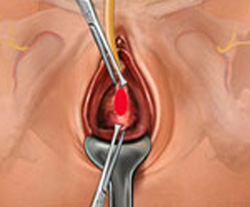
The TVT sling (tension free vaginal tape sling) was invented by Ulstem in 1996 and brought to the United States in the last 1990s. In the TVT procedure, a total of 3 small one centimeter incisions are made, two small 1 cm incisions are made at the pubic hair line, and an additional 1 cm incision is made suburethrally, at the midurethral level.
The procedure is performed under IV sedation or general anesthesia. The first step in the procedure is injection of local anesthesia suburethrally, at the midurethral level. (See the red dots). Then a 1 cm incision is made suburethrally. In addition, two small 1 cm incisions are made at the level of the pubic symphysis, located 2.5 cm lateral to the midline pubic symphysis on both sides.
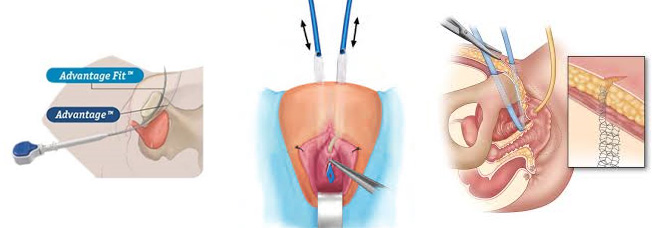
An introducer (with the sling attached) is passed through the suburethral incision into the retropubic space, and exiting at the pubic hair line, bilaterally. The sling attaches to the abdominal fascial wall for temporary support. True long-term support occurs when the patient’s own tissue grows into the holes of the sling for durable support, which takes approximately 6-8 weeks.
The sling is now placed at the midurethral level. The next step is the adjustment of the tension of the sling (which is the most important step). A curved Mayo scissor is placed between the sling and the urethra so that the sling will be placed in a tension-free manner. For patients with more severe incontinence, the tape needs to be placed a little tighter. For less severe incontinence, the tape is placed a little looser. This is the art of placement of the bladder sling. The sling needs to be placed just right. If the sling is too loose, then one will continue to have incontinence. If the sling is placed too tight, then there is a possibility for incomplete bladder emptying and urinary retention.
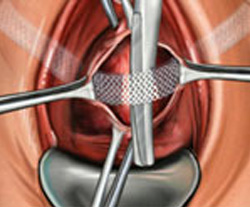
The success rate of the sling is approximately 90%. This is a 30-minute outpatient surgery with a recovery of less than one week. However, there are two important limitations from this surgery postoperatively. First, one cannot perform any heavy lifting for 2 months after the sling procedure. It takes approximately two months for one’s own tissue to grow into the sling to make the sling “strong.” This 2-month postoperative weight limitation applies to any type of sling surgery. The second limitation is showers only for 2 months--no baths, no pools, no Jacuzzis, and no intimacy for 2 months. It takes approximately 6-8 weeks for the three dissolvable sutures (placed vaginally) to be completely dissolved. This minimizes the risk for any type of surgical infection.
The most important factor in the placement of the sling is surgeon’s skill and experience. You want to find a surgeon who specialized in sling procedures and he/she has performed hundreds of bladder slings, rather than a less experienced surgeon who has only performed a small number of bladder slings.